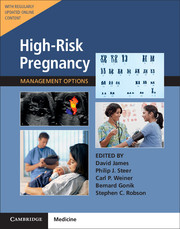Book contents
- Frontmatter
- Contents
- List of Contributors
- Preface
- Section 1 Prepregnancy Problems
- Section 2 Early Prenatal Problems
- Section 3 Late Prenatal – Fetal Problems
- Section 4 Problems Associated with Infection
- Section 5 Late Pregnancy – Maternal Problems
- Section 6 Late Prenatal – Obstetric Problems
- 52 Abdominal Pain in Pregnancy
- 53 Nonmalignant Gynecology in Pregnancy
- 54 Bleeding in Late Pregnancy
- 55 Multiple Pregnancy
- 56 Threatened and Actual Preterm Labor
- 57 Prelabor Rupture of the Membranes
- 58 Breech Presentation, Unstable Lie, Malpresentation, and Malpositions
- 59 Prolonged Pregnancy
- 60 Induction of Labor and Termination of the Previable Pregnancy
- 61 Dysfunctional Labor
- 62 Shoulder Dystocia
- 63 Fetal Compromise in Labor
- 64 Neuraxial Analgesia and Anesthesia in Obstetrics
- 65 Perineal Repair and Pelvic Floor Injury
- 66 Assisted Vaginal Delivery
- 67 Delivery After Previous Cesarean Section
- 68 Cesarean Section
- Section 7 Postnatal Problems
- Section 8 Normal Values
- Index
66 - Assisted Vaginal Delivery
from Section 6 - Late Prenatal – Obstetric Problems
- Frontmatter
- Contents
- List of Contributors
- Preface
- Section 1 Prepregnancy Problems
- Section 2 Early Prenatal Problems
- Section 3 Late Prenatal – Fetal Problems
- Section 4 Problems Associated with Infection
- Section 5 Late Pregnancy – Maternal Problems
- Section 6 Late Prenatal – Obstetric Problems
- 52 Abdominal Pain in Pregnancy
- 53 Nonmalignant Gynecology in Pregnancy
- 54 Bleeding in Late Pregnancy
- 55 Multiple Pregnancy
- 56 Threatened and Actual Preterm Labor
- 57 Prelabor Rupture of the Membranes
- 58 Breech Presentation, Unstable Lie, Malpresentation, and Malpositions
- 59 Prolonged Pregnancy
- 60 Induction of Labor and Termination of the Previable Pregnancy
- 61 Dysfunctional Labor
- 62 Shoulder Dystocia
- 63 Fetal Compromise in Labor
- 64 Neuraxial Analgesia and Anesthesia in Obstetrics
- 65 Perineal Repair and Pelvic Floor Injury
- 66 Assisted Vaginal Delivery
- 67 Delivery After Previous Cesarean Section
- 68 Cesarean Section
- Section 7 Postnatal Problems
- Section 8 Normal Values
- Index
Summary
Introduction
Assisted vaginal delivery is an important management option when difficulties arise in the second stage of labor. There is a choice to be made between forceps and vacuum extraction, and in some cases more than one instrument is used. In addition to choosing an instrument, the operator must decide when to intervene, where to conduct the delivery, when to seek senior support, which alternative to employ if the chosen instrument fails, and when to abandon an attempt at assisted vaginal delivery in favor of cesarean section.
Assisted vaginal delivery rates in the UK have remained relatively stable, accounting for between 10% and 15% of all births. Rates are lower in some other parts of the world, with marked variation in the choice of instrument used. The use of forceps or vacuum extraction by competent operators, for appropriate indications, results in safe and satisfactory outcomes for the majority of women and their babies. When adverse outcomes occur and causation is considered, it can be difficult to determine the relative contributions of the indication for assisted vaginal delivery and the conduct of the delivery itself. As a result, assisted vaginal delivery can result in litigation, particularly when neurological injury results in cerebral palsy or persistent brachial plexus injury.
The complex nature of assisted vaginal delivery (both decision making and procedural) poses a challenge for research. The management options presented are informed by Cochrane systematic reviews of randomized controlled trials (RCTs), practicebased guidelines of organizations including the Royal College of Obstetricians and Gynaecologists (RCOG), the American College of Obstetricians and Gynecologists (ACOG), and the National Institute for Health and Care Excellence (NICE), and high-quality epidemiological and qualitative studies.
Classification
The aim of assisted vaginal delivery is to mimic spontaneous vaginal birth, expediting delivery with a minimum of maternal and perinatal morbidity. The classification of assisted vaginal deliveries should correspond with the physiological stages of the normal second stage of labor including engagement, rotation and descent of the presenting part onto the pelvic floor, and crowning of the head as it distends the perineum. A standard classification system based on station and position is presented in Table 66.1. Application of a classification system in all cases of vacuum and forceps delivery allows accurate communication between health professionals, audit of outcomes, and valid comparative studies between operators, institutions, and international settings.
- Type
- Chapter
- Information
- High-Risk Pregnancy: Management OptionsFive-Year Institutional Subscription with Online Updates, pp. 1867 - 1889Publisher: Cambridge University PressFirst published in: 2017

